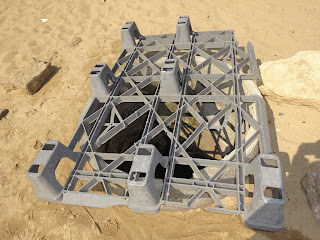This time, I think I got it right.
Like Coleridge’s Ancient Mariner I shouted but with glee, ‘water, water,
everywhere, but not a drop to drink!’ I was standing mesmerized at Dhanuskodi,
viewing the vast swathe of low tide, which brought in the sea waters of Bay of
Bengal to my feet.
Dhanuskodi is a ghost town. It was
wiped away completely in an immense cyclone that hit the area in December 1964.
Bay of Bengal, the sea that laps on the eastern border of India and Indian
ocean that covers the southern side of the country, which derives its name from
the country India, meet at this point in Dhanuskodi. It lies in Pamban island
connected to Mandapam in the main land by Pamban bridge. Dhanuskodi is the last
point of land in India as it tapers towards the island Sri Lanka, which takes
shape from that point.
Traditions have that Rama, an ancient
king of India from the north, the hero of Ramayana, an epic poem of ancient
India, came in hot pursuit of Ravana, who had kidnapped his wife, Seetha and
held her captive in the Sri Lankan island. His friends built a bridge at
Dhanuskodi for his troops to cross over to Sri Lanka.
My interest in the place was not
definitely religious. But that didn’t deter my companion taking a wistful
plunge in the sea and observing all the rituals connected with it, including 22
buckets of water poured over her head as theerthams
and emerging completely satisfied like a cat that has got its stomach full with
good milk!
I was fascinated by the story of the cyclone
that hit Dhanuskodi. A low pressure that built near Andaman and Nicobar
Islands in Andaman sea, east of Tamil Nadu in India, on 18th December
1964, developed into a cyclone of mammoth proportions. By 23rd December
it developed into a hurricane with a wind velocity of 240 km/h (150 mph) and
struck the then Ceylon (now Sri Lanka) near Mannar, causing extensive damage
and loss of life of over 2000 people.
On the Indian side Pamban island bore
the brunt. Dhanuskodi lay almost at the tip of the island on Indian side as it
tapers towards Sri Lanka and on the other side it was Mannar of Ceylon. Dhanuskodi
was completely submerged under the deluge. Huge tidal waves of 25 feet (7.6
meters) washed away everything that was standing in the place.
A passenger train carrying 110 people
and 5 railway staff got completely washed away, killing all the passengers. The
train was coming from the mainland through Pamban station to Dhanuskodi
station. The time was 11 pm and the train was just minutes away from reaching
Dhanuskodi station. Huge tidal waves hit the train and it was seen no more. Today
all that is left of the train are some twisted metal of the train tract, a
witness to that gory night of disaster.
The Pamban bridge that was connecting
Pamban island with the mainland at Mandapam on the east coast of Tamil Nadu
got washed away as well. The bridge was rebuilt only in 2012.
Dhanuskodi was declared by the Government
of India as a place unfit for human habitation. I was reminded of some of the
Old Testament towns, which were destroyed in war and prophesied that they will
never again be inhabited by people. One such place was Jericho. Many of the
towns mentioned in the Old Testament still stand, but not Jericho. It is a dead
city. So also Dhanuskodi.
 We travelled in minibuses to the
ghost town and these buses full of people were winding their paths in and
around the low tide area, over puddles of sea water left behind by the tide, with
twists and some dangerous turns. I was reminded of the Jeep Safari on the sandy
deserts of Dubai, where the drivers took their vehicles over the sand mounds
and would suddenly sweep down giving the passengers a thrill or fear depending
on the person concerned.
We travelled in minibuses to the
ghost town and these buses full of people were winding their paths in and
around the low tide area, over puddles of sea water left behind by the tide, with
twists and some dangerous turns. I was reminded of the Jeep Safari on the sandy
deserts of Dubai, where the drivers took their vehicles over the sand mounds
and would suddenly sweep down giving the passengers a thrill or fear depending
on the person concerned.
The sea itself looks so calm and
quiet and innocent. It is nicknamed as the ‘lady sea,’ especially during such
low tide. The present day Dhanuskodi looks deserted, except for some 20 odd
families, living there in shacks, selling pebbles and shells and some ‘nimbu pani’ (lemonade).
The best was the lemonade was made with water drawn from a well simply dug in the ground close to the shop and sweet water to drink in a place surrounded by sea water. Amazing!
The well!
It might be built again, you never
know.
Hope, after all, is the beacon of life!






No comments:
Post a Comment